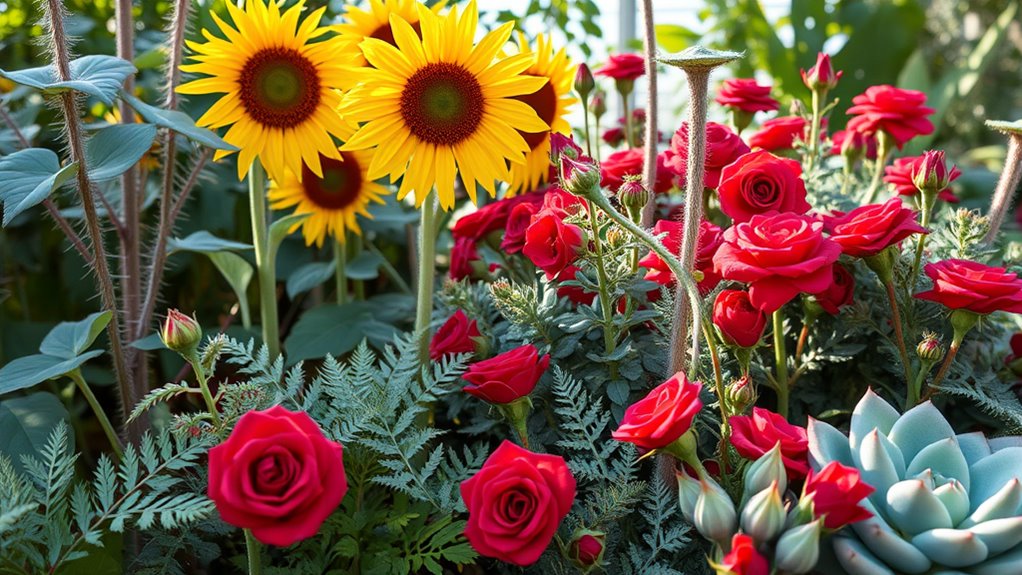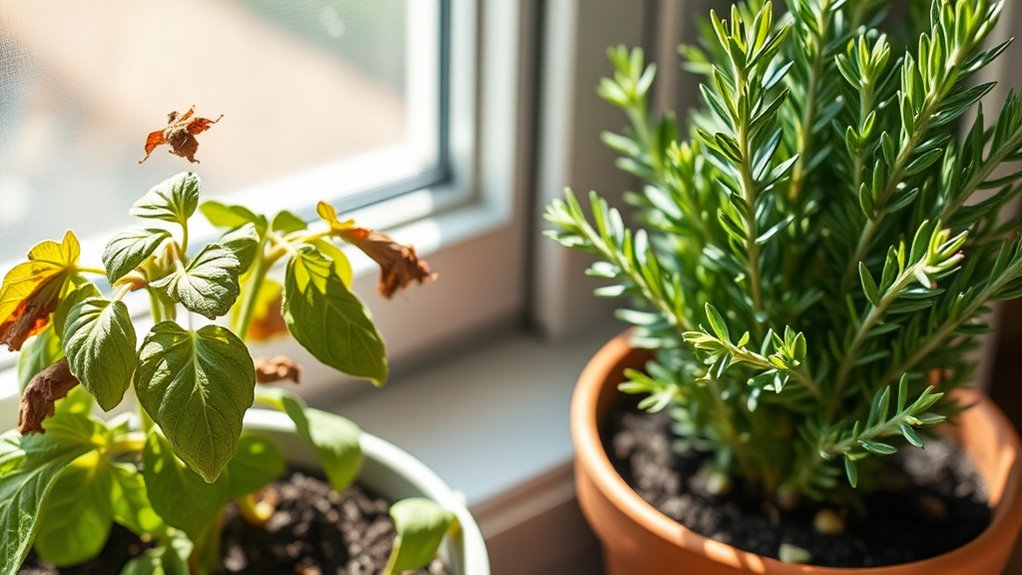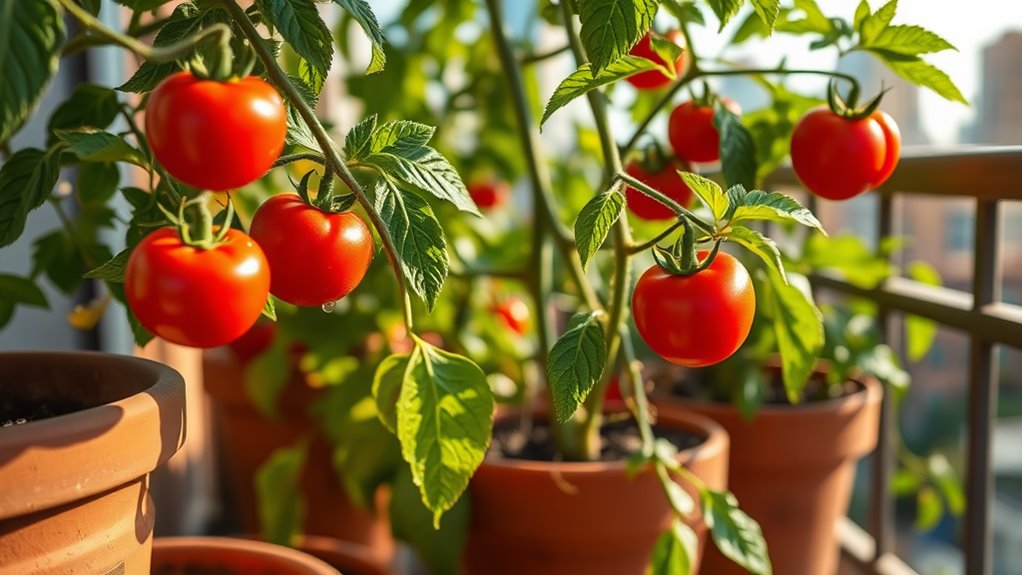These Plant Combos Grew Better Together Than Alone!
You’ll find that strategic plant pairings, like tomatoes with basil, make your garden thrive by repelling pests and boosting yields up to 20%. Beans and corn work hand in hand, with beans fixing nitrogen to fuel corn’s growth, while marigolds alongside vegetables naturally deter harmful insects. These combos enhance soil health and biodiversity for a more productive space. Check out more pairings below to supercharge your gardening results.
Key Takeaways
- Tomatoes and basil repel pests and boost yields when planted together.
- Beans and corn enhance growth through nitrogen fixation in companion planting.
- Marigolds with vegetables deter insects, leading to healthier plants.
- Strawberries paired with beans improve harvests via soil nutrient enrichment.
- Carrots beside onions protect against pests for better overall production.
Benefits of Companion Planting in Gardens
When you pair compatible plants in your garden, companion planting boosts growth and health by naturally repelling pests, improving soil nutrients, and maximizing space. Drawing from personal experiences like my first attempt with selected plant pairs, gardeners can anticipate surprising results that further enhance overall garden productivity.
You’ll find that perfect plant pairs, like those using nitrogen-fixing legumes with heavy feeders, enhance soil fertility through symbiotic relationships, reducing the need for synthetic fertilizers.
This approach actively deters harmful insects via natural repellents, such as aromatic herbs, while optimizing garden layout for better light and airflow.
Scientifically, it promotes biodiversity, leading to resilient ecosystems that you can manage practically with minimal intervention, yielding healthier harvests overall.
By implementing specific plant combinations, gardeners can achieve even greater enhancements in growth and pest deterrence as outlined in companion planting resources.
Top Vegetable Plant Pairs for Optimal Growth
You can boost your garden’s efficiency by pairing tomatoes with basil, which naturally repels pests and enhances flavor. Moreover, this basil and tomato combination can significantly improve plant growth for better overall yields.
Beans and corn work together as beans fix nitrogen in the soil to support corn’s growth, creating a mutually beneficial setup.
Carrots beside onions deter carrot flies through onions’ strong scent, helping you achieve healthier yields with these practical combinations.
Additionally, marigolds planted with vegetables can enhance garden health while repelling harmful insects for a more vibrant garden.
Tomatoes With Basil
Basil and tomatoes form a classic companion pair that boosts garden productivity.
You’ll find that basil repels pests like aphids and hornworms, keeping your tomato plants healthier and reducing chemical needs.
Scientifically, basil emits compounds that deter insects and may enhance tomato flavor through allelopathy.
Plant basil around your tomatoes for optimal spacing—about 12 inches apart—to maximize sunlight and airflow.
This setup increases your yields; studies show companion planting raises fruit production by up to 20%.
You’re harvesting more while promoting a balanced garden ecosystem.
Try it to see the difference firsthand.
Beans and Corn
Beans and corn stand out as a premier companion pair in vegetable gardening, with beans enriching soil nitrogen to fuel corn’s vigorous growth.
You plant beans at corn’s base, where they climb the stalks for support, reducing your need for trellises.
Scientifically, beans’ rhizobia bacteria fix atmospheric nitrogen, boosting corn’s nutrient uptake and yielding up to 20% more produce.
In practice, space corn 12 inches apart in rows, sowing beans nearby after corn sprouts.
This combo minimizes pests, conserves water, and maximizes your garden’s productivity, making it a smart, sustainable choice.
Carrots Beside Onions
Carrots and onions make a stellar companion pair, with onions’ strong scent deterring carrot flies and pests while carrots’ deep roots avoid competing for shallow soil nutrients.
When you plant them together, you’ll maximize space and resources, leading to healthier crops and higher yields in your garden.
-
Pest management: Onions emit sulfur compounds that confuse and repel carrot flies, reducing infestation risks for you.
-
Nutrient synergy: Carrots’ deep roots access subsoil nutrients, allowing onions’ shallow roots to thrive without competition, enhancing efficiency.
-
Growth optimization: This pairing improves soil aeration and moisture retention, boosting your overall harvest quality and quantity scientifically.
Flowering Plants That Enhance Each Other
When you pair certain flowering plants, such as marigolds with tomatoes, they naturally boost each other’s growth by repelling pests and attracting beneficial pollinators, making your garden more productive and resilient.
You can also try nasturtiums with cucumbers; they ward off aphids and draw in pollinators, while zinnias paired with beans attract helpful insects that protect beans from harm.
Scientifically, these interactions enhance biodiversity, reduce chemical dependency, and improve soil health through root exudates. However, it’s essential to avoid harmful pairings that can lead to poor growth and pest issues.
In your garden, you’ll notice stronger plants, higher yields, and a thriving ecosystem, so experiment carefully for optimal results.
To maximize these benefits, gardeners should be aware of common mistakes like improper spacing or selecting incompatible plants that can hinder growth.
Herb Combinations for a Thriving Garden
You select the best herb pairs, like basil and tomatoes, to naturally deter pests and improve growth in your garden.
These thriving combos, such as rosemary with beans, enhance soil health and yield through companion planting. Additionally, incorporating low-maintenance herbs can ensure these pairs thrive with minimal effort, drawing from resilient options like thyme or oregano.
To maximize benefits, consider perfect plant pairs such as mint with cabbage to repel pests effectively.
Best Herb Pairs
While individual herbs can thrive alone, pairing them with compatible companions often boosts garden vitality and yield.
You’ll enhance your garden’s health by choosing pairs that naturally deter pests and improve soil quality, leading to bountiful harvests.
-
Basil and parsley: Basil repels aphids effectively, while parsley enriches soil with nutrients, promoting stronger growth and higher yields for you.
-
Rosemary and sage: These herbs share drought tolerance and ward off garden moths, fostering mutual resilience and intensifying flavors in your beds.
-
Mint and oregano: Mint deters ants and fleas from oregano, and their intertwined roots retain moisture, ensuring robust, sustainable plants in your space.
Thriving Garden Combos
Building on successful herb pairs, effective combinations can transform your garden into a resilient ecosystem, where herbs work together to repel pests, enrich soil, and maximize yields through strategic planting.
For instance, plant basil with tomatoes; basil’s oils deter insects while enhancing tomato growth.
Pair rosemary with beans; rosemary repels bean beetles, and beans fix nitrogen, boosting rosemary’s vigor.
Mint alongside cabbage repels cabbage moths, but contain it to prevent spread.
You’re optimizing space and resources—test these combos in your plot for science-backed results, like increased biodiversity and higher harvests through natural synergies.
Fruit-Bearing Plants That Work in Tandem
Certain fruit-bearing plants thrive in tandem, boosting each other’s growth, deterring pests, and maximizing yields through strategic pairings. By using sustainable fertilizing methods, you can further enhance the soil health and overall vitality of these plant combinations.
As you cultivate your garden, you’ll discover how these combinations enhance productivity and sustainability. Here’s how you can apply this scientifically:
-
Nitrogen enrichment: Pair strawberries with beans; beans fix nitrogen in the soil, fueling strawberry vigor and boosting your harvests.
-
Pollination support: Plant apple trees near flowering cover crops like clover; this attracts pollinators, increasing fruit set and quality for you.
-
Space optimization: Grow grapes with low-growing legumes; they provide ground cover, reducing weeds while you maximize yields in limited areas.
However, to maintain optimal garden health, be sure to avoid planting vegetables that don’t get along alongside these beneficial pairs, as they can hinder growth and reduce overall yields.
Natural Pest Control Through Plant Pairing
Just as fruit-bearing plants benefit from strategic pairings, you can harness natural pest control by combining specific plants that repel insects and diseases without chemicals.
For instance, plant marigolds alongside tomatoes; their roots release compounds that deter nematodes and aphids.
Pair basil with peppers to emit scents that ward off flies and mosquitoes.
You’ll find garlic interplanted with roses repels beetles effectively.
These combinations reduce pest damage naturally, boosting your garden’s health and yield.
Furthermore, integrating eco-friendly methods like crop rotation can provide extra protection.
Experiment with these duos in your plot for sustainable, chemical-free results.
Additionally, these plant combinations can be complemented by other unconventional remedies for even more effective pest management.
Soil Health Boosters: Plant Duos to Try
While pests can challenge your garden, you can improve soil health by pairing plants that naturally enrich nutrients and structure.
These duos foster symbiotic relationships that boost fertility and prevent degradation, making your soil more productive over time.
-
Beans and corn: Beans fix atmospheric nitrogen, supplying corn with essential nutrients while corn’s structure shades and supports beans, enhancing overall soil nitrogen levels.
-
Clover and grains: Clover adds organic matter and fixes nitrogen, improving grain yields; this duo builds soil structure and reduces the need for synthetic fertilizers.
-
Comfrey and vegetables: Comfrey’s deep roots mine minerals from subsoil, enriching the top layer for vegetables, promoting better aeration and microbial activity for sustained health.
Shade-Tolerant Plant Combinations
In shaded garden spots where sunlight is limited, you can pair shade-tolerant plants to maximize growth and vitality.
Consider combining hostas with ferns; hostas’ broad leaves retain soil moisture, while ferns provide ground cover and suppress weeds effectively.
Pair astilbes with heucheras; astilbes attract pollinators with their plumes, and heucheras enrich soil through nutrient uptake.
These combinations reduce pest pressure and enhance resilience in low-light areas.
You’ll observe improved vigor and fewer diseases, making your shaded garden thrive with minimal intervention.
Experiment carefully for optimal results.
Drought-Resistant Plant Teams for Arid Areas
If you’re gardening in arid areas, you’ll want to start with drought-tolerant pairs that pair water-efficient plants like succulents with deep-rooted perennials to minimize irrigation needs.
These combos help you build resilient landscapes by selecting species that naturally conserve moisture and support each other.
Now, consider arid region combos that optimize soil health and reduce evaporation for long-term success.
Drought-Tolerant Pairs
Creating drought-tolerant plant pairs helps you thrive in arid environments by combining species that conserve water and withstand heat.
You’ll maximize growth by selecting plants that support each other’s resilience, reducing overall water needs while boosting ecosystem health.
-
Pair deep-rooted species with shallow-rooted ones****: This allows you to access different soil moisture levels, ensuring steady water uptake and minimizing competition.
-
Combine reflective foliage with shade providers: You’ll reduce surface temperatures and evaporation, creating a microclimate that enhances drought survival.
-
Incorporate soil-enriching plants****: These help you maintain nutrient balance, fostering robust root systems that efficiently store and use limited water.
Arid Region Combos
Arid regions demand strategic plant teams that thrive with minimal water, so you’ll pair species like agave and mesquite to maximize drought resistance while enhancing soil stability.
Agave’s deep roots access underground moisture, while mesquite’s nitrogen-fixing abilities enrich depleted soils, fostering mutual growth.
You’ll also combine prickly pear with yucca; the former shades soil to reduce evaporation, and the latter’s waxy leaves conserve water.
These combos boost biodiversity, prevent erosion, and improve yields—plant them in clusters for optimal microclimates, ensuring long-term resilience in harsh, dry environments.
Test soil pH first for best results.
Beginner-Friendly Plant Mixes for Success
As you dive into gardening, pairing beginner-friendly plants simplifies your path to success by matching their needs for water, light, and soil.
These combinations reduce maintenance while enhancing growth through natural synergies.
-
Tomatoes and basil: You grow them together for pest resistance; basil’s oils deter insects, and both prefer sunny spots, boosting flavor and yield.
-
Lettuce and radishes: Plant them side by side; radishes break up soil for lettuce roots, and their quick harvest prevents overcrowding in partial shade.
-
Marigolds and beans: You interplant for nematode control; marigolds release compounds that protect beans, ensuring both flourish in well-drained soil.





